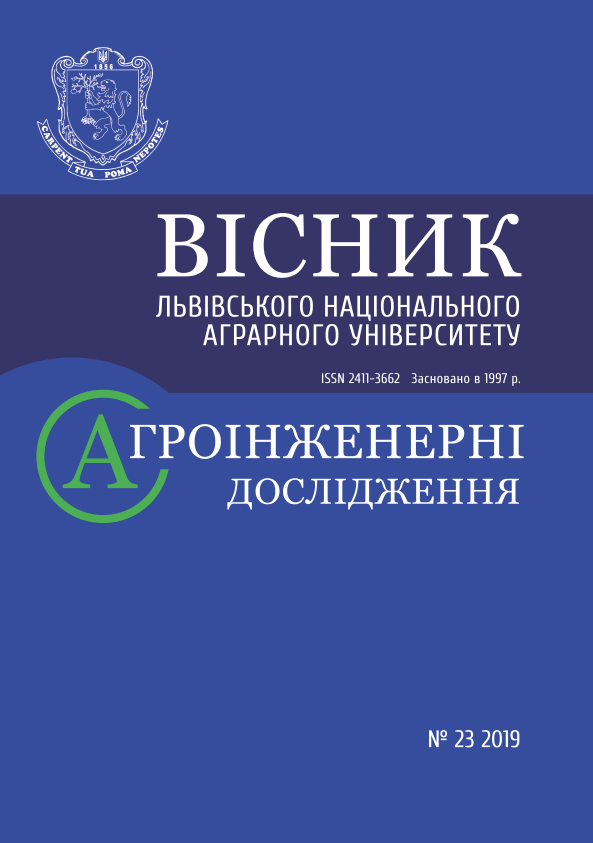RESEARCH OF SYMMETRIC COMPONENTS OF VOLTAGE IN THE DISTRIBUTION NETWORK 0,38 / 0,22 KV
DOI:
https://doi.org/10.31734/agroengineering2019.23.090Keywords:
current asymmetry, voltage asymmetry, loss of electrical energyAbstract
The article deals with the problem of asymmetrical modes in 0,38 / 0,22 kV networks. It is shown that the asymmetry of the currents is caused by the work of communal-household load, the main part of which is unevenly distributed in the phases of single-phase electric receivers. Determining the amount of asymmetry in the network allows specifying of the level of electricity losses. In some electricity companies, losses in the 0,38 / 0,22 kV networks reach up to 15 % of the electricity supplied to the grid, and the electricity quality indicators exceed the allowable values by 2 – 4 times. In European countries, it is considered that if electricity losses exceed 7 – 9 %, then such electricity transmission is considered inefficient. Therefore, it became necessary to develop new methods and measures to improve the quality of electricity and to take appropriate measures to reduce losses.
The research proposes a mathematical method for calculating the symmetric components of the 0,38 / 0,22 kV network voltage, which can be the basis of a mathematical apparatus for developing of a software product, designed for calculation of voltage asymmetry. It is shown that in the system of symmetric coordinates the corresponding current and voltage matrices contain components of forward, reverse and zero sequences. It was also investigated that the resistance of the straight and zero sequences of the three-phase line is calculated or experimentally studied, with the resistance of the forward and reverse sequences for the lines being the same, and the resistance of the zero sequence can be 2-3 times greater than the resistance of the direct sequence. It is caused by the difference in the values of the emf mutual induction, induced in the phase by currents of direct and zero sequences flowing in the other two phases.
References
Bogatyrev, L. L., Manusov, V. Z., & Sodnomdorzh, D. (1999). Matematicheskoe modelirovanie rezhimov EES v usloviyah neopredelennosti. Ulan-Bator: Izd-vo tipografii MGTU.
Levin, M. S., & Leschinskaya, T. B. (1999). Analiz nesimmetrichnykh rezhimov selskikh setei 0,38 kV. Elektrichestvo, 5, 18–22.
Lezhniuk, P. D., Buryikin, A. B., & Kulik, V. V. (2009). Opredelenie poter elektroenergii v elektricheskikh setyakh energosistem ot tranzitnykh peretokov. Pratsi Institutu elektrodinamiki NAN Ukriyinu. Spets. vyp. Energetichni rinki – perekhid do novoii modeli rynku dvostoronnikh kontraktiv i balansuiuchoho rinku, 31–36.
Lezhniuk, P. D., Kulik, V. V., & Polishchuk, A. L. (2007). Informatsiine zabezpechennia rozrakhunku vtrat elektroenerhii v rozpodilnykh merezhakh. Visnyk HNTUSG «Problemi enerhozabezpechennia ta enerhozberezhennia v APK Ukraiiny», 57(1), 17–21.
Miroshnyk, O. O. (2007). Metody ta pidkhody do rozrakhunku vtrat elektrichnoii enerhii v rozpodilchykh elektrychnykh merezhakh. Pratsi Tavriiskoho derzhavnoho ahrotekhnolohichnoho universytetu, 7(3), 31–36.
Savina, N. V., & Voropay, N. I. (red). (2008). Sistemnyi analiz poter elektroenergii v elektricheskikh raspredelitelnykh setiah: Monografia. Novosibirsk: Nauka.
Chitra, R., & Neelaveni, R. (2011). A Realistic Approach for Reduction of Energy Losses in Low Voltage Distribution Network. International Journal of Electrical Power & Energy Systems, 33, 377–384. doi: https://doi.org/10.1016/j.ijepes.2010.08.033.
Dilek, M., Broadwater, R. P., Thompson, J. C., & Sequin, R. (2001). Simultaneous Phase Balancing at Substations and Switches with Time-Varying Load Patterns. IEEE Transactions on Power Systems, 16, 922–928. doi: https://doi.org/10.1109/59.962447.
Erturk, A. T. (2017) Manufacturing of Al-Zr Thermal-Resistant Alloys for Transmission Lines. Acta Physica Polonica, 127, 1292–1294. doi: https://doi.org/10.12693/APhysPolA.127.1292.
Faiz, J., & Ebrahimpour, H. (2006). Influence of Unbalanced Voltage Supple on Ef-ficiency of Three Phase Squirrel Cage Induction Motor and Economic Analysis. IEEE Transactions on Energy Conversion, 47, 289–302. doi: https://doi.org/10.1016/j.enconman.2005.04.009.
Faiz, J., & Ebrahimpour, H. (2007). Precise Derating of Three-Phase Induction Motors with Unbalanced Voltages. Energy Conversion and Management, 48, 2579–2586. doi: https://doi.org/10.1016/j.enconman.2007.03.023.
Karabay, S. (2013). Enhancement on Al-Mg-Si Alloys against Failure Due to Lightning Arc Occurred Inenergy Transmission Lines. Engineering Failure Analysis, 31, 153–160. doi: https://doi.org/10.1016/j.engfailanal.2013.02.005.
Miroshnyk, O., & Trunova, I. (2018) The incentive scheme for maintaining or improving power supply quality. IEEE 3rd International Conference on Intelligent Energy and Power Systems, IEPS 2018 - Proceedings 2018-January. doi: 10.1109/IEPS.2018.8559553.
Miroshnyk, O. O., & Tymchuk, S. O. (2013). Uniform distribution of loads in the electric system 0.38/0.22 kV using genetic algorithms. Technical Electrodynamics, 4, 67–73. URL: http://www.scopus.com/inward/record.url?eid=2-s2.0-84885913005&partnerID=MN8TOARS.
Tavakoli Bina, M., & Kashefi, A. (2011). Three-Phase Unbalance of Distribution Systems: Complementary Analysis and Ex-perimental Case Study. International Journal of Electrical Power & Energy Systems, 33, 817-826. doi: https://doi.org/10.1016/j.ijepes.2010.12.003.
Thyristor Converter as a Means of Upgrading the Single-Phase Furnace. URL: http://www.elec.ru/articles/tiristornyj-preobrazovatel-kak-sredstvo-modernizac/


